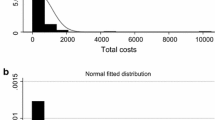Abstract
Objective: The principle aim of this study was to generate a league table of drugs considered by the Australian Pharmaceutical Benefits Advisory Committee (PBAC) for reimbursement. The table was used to test the hypothesis that decisions made by the PBAC are consistent with the maxim of economic efficiency. In addition, we explored whether the past decisions by the PBAC revealed a threshold incremental cost-effectiveness ratio beyond which the PBAC is not prepared to recommend reimbursement of a drug.
Methods: All 355 submissions made to the PBAC between January 1991 and June 1996 were reviewed. Submissions using cost per life-year gained (26 submissions) or the cost per quality adjusted life-year (QALY) gained (9 submissions) were ranked in a league table and compared with advice given by the PBAC about that drug. The confidentiality restrictions for the submissions require that the individual drug details cannot be revealed in this article.
Results: There was a statistically significant difference between the cost per life-year gained for drugs that were recommended for listing and those that were not, suggesting that the PBAC has been broadly consistent with the use of economic efficiency as a criterion for decision making. We did not find an explicit threshold beyond which the PBAC was unwilling to pay for additional life years gained. However, between 1992 and 1996 the PBAC appears to have been unlikely to recommend a drug for listing if the additional cost per life-year exceeded 76 000 Australian dollars [$AU] (1998/1999 values) and was unlikely to reject a drug for which the additional cost per life-year gained was less than $AU42 000. The cost-effectiveness ratio was not the only factor determining the reimbursement decision.
Conclusions: The results of this preliminary study indicate that decisions to recommend a drug for listing by the PBAC in the last few years have, by and large, been consistent with the notion of economic efficiency.


Similar content being viewed by others
References
Hall J. Research into action: does economic evaluation affect health policy or practice? In: Harris A, editor. Proceedings of the 17th Australian Conference of Health Economists, 1995 Jul. Australian Studies in Health Services Administration no. 80. Sydney: School of Health Services Management, University of New South Wales, 1995
Canadian Coordinating Office of Health Technology Assessment (CCOHTA). Guidelines for Economic Evaluation of Pharmaceuticals. 1st ed. Canada, Ottawa: CCOHTA, 1994
Pharmaceutical Management Agency (PHARMAC). The first 20 months. Wellington: PHARMAC, 1995
Department of Health. Memorandum of Understanding on Appraisal of Health Interventions. London: Department of Health, 1999
Department of Health. Faster access to modern treatment: how NICE appraisal will work. A discussion paper. London: Department of Health, 1999
Hay J. Pharmaecoeconomic guidelines: where do we go from here? Value Health 2001; 4: 211–50
Richardson J. Cost-utility analysis: what should be measured? Soc Sci Med 1994; 39(1): 7–21
Ryan M. Using willingness to pay to assess the benefits of assisted reproductive techniques. Health Econ 1996; 5(6): 543–8
Johannesson M, Johansson PO, Kristrom B, et al. Willingness to pay for antihypertensive therapy: further results. J Health Econ 1993; 12(1): 95–108
Reid W. Willingness to pay for diagnostic services: a new approach to modelling patient benefits in health care. Health Econ 1994; 3: 55–266
Johannesson M. Theory and methods of economic evaluation of health care. Dordrecht: Kluwer, 1996
Gold MR, Seigel JE, Russell LB, et al., editors. Cost-effectiveness in health and medicine. New York (NY): Oxford University Press, 1996
Williams AH. Economics of coronary artery bypass grafting. BMJ 1985; 291: 326–9
Maynard A. Developing the health care market. Economic J 1991; 101: 1277–86
Australian Institute of Health. Cervical cancer screening in Australia: options for change. Canberra: Australian Government Publishing Service, 1991
Tengs TO, Wallace A. One thousand health-related quality-of-life estimates. Med Care 2000; 38(6): 583–637
Weinstein M. From cost-effectiveness ratios to resource allocation: where to draw the line? In: Sloan FA, editor. Valuing health care: costs, benefits, and effectiveness of pharmaceuticals and other medical technologies. Cambridge: Cambridge University Press, 1995: 77–97
Mason J. Cost per QALY league tables: their role in pharmacoeconomic analysis. Pharmacoeconomics 1994; 5(6): 472–81
Gerard K, Mooney G. QALY league tables, handle with care. Health Econ 1993; 2: 59–64
Drummond M, Torrance G, Mason J. Cost-effectiveness league tables:more harmthan good. Soc Sci Med 1993; 37(1): 33–40
Commonwealth Government of Australia. Guidelines for the pharmaceutical industry on the preparation of submissions to the Pharmaceutical Benefits Advisory Committee. Canberra: Department of Health and Family Services, 1995
Commonwealth Government of Australia. National Health Act. 1953
Commonwealth Government of Australia. Amendment to the National Health Act 1953 Subsection 3(a). 1987
Australian Bureau of Statistics. Australian economic indicators. Canberra: Australian Government Publishing Service, 1999
Hill S, Mitchell A, Henry D. Problems with the interpretation of pharmacoeconomic analyses: a review of submissions to the Australian Pharmaceutical Benefits Scheme. JAMA 2000; 283(16): 2116–21
Hadourn DC. Setting health care priorities in Oregon: cost-effectiveness meets the rule of rescue. JAMA 1991; 265(17): 2219–25
Acknowledgements
We are grateful to Don Lewis, for his comments on the paper. This study was carried out at the Health Economics Unit, Centre for Health Program Evaluation, Monash University, Melbourne. An earlier version of this paper was presented at the Conference of the Australian Health Economists in Melbourne, July 1997. This study was conducted with the help of a grant from the Centre for Health Program Evaluation, Monash University, Melbourne.
Author information
Authors and Affiliations
Corresponding author
Rights and permissions
About this article
Cite this article
George, B., Harris, A. & Mitchell, A. Cost-Effectiveness Analysis and the Consistency of Decision Making. Pharmacoeconomics 19, 1103–1109 (2001). https://doi.org/10.2165/00019053-200119110-00004
Published:
Issue Date:
DOI: https://doi.org/10.2165/00019053-200119110-00004




